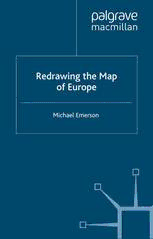
Redrawing the Map of Europe PDF
Preview Redrawing the Map of Europe
REDRAWING THE MAP OF EUROPE This page intentionally left blank Redrawing the Map of Europe Michael Emerson Centre for Economic Performance London School of Economics and Political Science tt AS First published in Great Britain 1998 by MACMILLAN PRESS LTD Houndmills, Basingstoke, Hampshire RG21 6XS and London Companies and representatives throughout the world A catalogue record for this book is available from the British Library. ISBN 0-333-73446-7 hardcover ISBN 0-333-73447-5 paperback First published in the United States of America 1998 by AS ST. MARTIN'S PRESS, INC., Scholarly and Reference Division, 175 Fifth Avenue, New York, N.Y. 10010 ISBN 0-312-21697-1 Library of Congress Cataloging-in-Publication Data Emerson, Michael. Redrawing the map of Europe / Michael Emerson, p. cm. Includes bibliographical references and index. ISBN 0-312-21697-1 (cloth) 1. Europe—Politics and government—1989- I. Title. D2009.E49 1998 940.55'9—«ic21 98-21461 CIP © Michael Emerson 1998 All rights reserved. No reproduction, copy or transmission of this publication may be made without written permission. No paragraph of this publication may be reproduced, copied or transmitted save with written permission or in accordance with the provisions of the Copyright, Designs and Patents Act 1988, or under the terms of any licence permitting limited copying issued by the Copyright Licensing Agency, 90 Tottenham Court Road, London W1P 9HE. Any person who does any unauthorised act in relation to this publication may be liable to criminal prosecution and civil claims for damages. The author has asserted his right to be identified as the author of this work in accordance with the Copyright, Designs and Patents Act 1988. This book is printed on paper suitable for recycling and made from fully managed and sustained forest sources. 10 9 8 7 6 5 4 3 21 07 06 05 04 03 02 01 00 99 98 Printed and bound in Great Britain by Antony Rowe Ltd, Chippenham, Wiltshire for Elena This page intentionally left blank Vll Contents List of Tables, Figures and Appendix x List of Maps xii Glossary xiii Acknowledgments xv The Main Argument xvii Maps xxii 1. Introduction 1 2. Integration 7 2.1 Principles of integration 7 2.2 Historical integration 10 - Geography 10 - Culture 11 -Perceptions 17 2.3 Economic integration 23 - Market integration 23 - Monetary integration 27 - Regional redistribution 31 2.4 Political integration 33 - Values 33 - Power 35 - Security 37 2.5 Dynamics 38 Vlll Contents 3. Conflict 44 3.1 Why conflict? 44 3.2 Human costs of conflict 5 0 3.3 Economic costs of conflict 51 3.4 Europe's 21st century 55 3.5 Checking out the ethnic flashpoint 59 - Western Europe 63 - EU candidate countries 67 - CIS Europe 74 - Other Balkans 78 3.6 Dynamics again 80 4. Economics 84 4.1 Rules of open markets 85 4.2 The euro policy quartet 90 4.3 Rules for macroeconomic stability 92 - Qualifications for the euro area 92 - Monetary policy of the European Central Bank 101 - Budgetary policy under the Stability and Growth Pact 102 - Monetary-budgetary policy mix and the exchange rate 105 4.4 The labour market-social-regional policy nexus 109 - Social model and the unemployment problem 109 - Regional economics 116 4.5 Avoiding a new inconsistent quartet 120 4.6 Rules of corporate governance 122 5. Security 128 5.1 Democratic institutions 129 - Rules of democracy 129 - State of democracy 131 -Outlook 136 - Monitoring democracy 13 7 5.2 Human rights 140 5.3 National minorities and conflict resolution 146 5.4 Policing Europe 151 Contents IX 5.5 Military security 153 - Three security maps 153 -NATO-WEU-EUtrio 158 -Bosnia again 161 - Elementary effectiveness 163 - Geopolitics of a four-player game 165 6. Institutions 171 6.1 The unidentified political object 172 6.2 Three paradigms for Europe 175 - The federal paradigm 175 - The paradigm of cosmopolitan democracy 180 - The management paradigm 185 6.3 Three general purpose organisations 188 - European Union 18 8 - Commonwealth of Independent States 200 - European Civil Society 202 6.4 The Euro-village 209 7. Conclusions - of Rules and Maps 213 7.1 Sources of integration 215 7.2 Sources of conflict 217 7.3 Eight rules for a European civil society 218 7.4 Three paradigms 222 7.5 Four maps 225 7.6 A new European golden age 229 Annex 237 A Membership of European organisations 237 B Demographic and economic indicators of Europe 239 C National minorities in central and eastern Europe 241 D Wars and war-related deaths in Europe, 1990-95 244 References 247 Index
